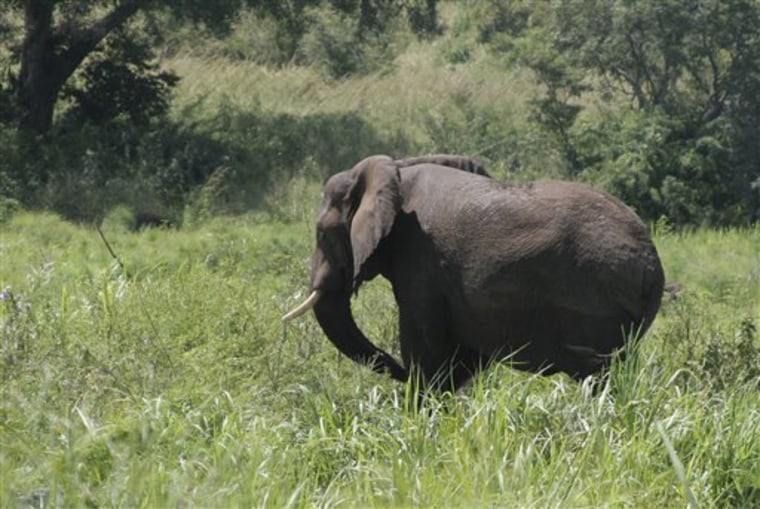The hippos had fled to other islands in the White Nile, driven away by one of the few forces that can dislodge a large herd of these fierce beasts — an even larger herd of elephants.
And there they were: some 50 elephants, massive black figures peacefully grazing on their newly reclaimed territory on the Nile island of Opekoloe.
“To anyone who thought they’d disappeared forever, it’s like magic,” said Lt. Col. Charles Joseph, deputy warden of south Sudan’s Nimule national park near the border with Uganda, barely containing his excitement as he waded knee-deep through reed-filled water to approach the herd.
Sudan’s 22-year north-south civil war — Africa’s longest and bloodiest conflict, killed some two million people. It also drove out large numbers of animals.
Now after two years of relative peace, they’re dramatically back. Wildlife services estimate 7,000 elephants have returned, along with some 1,500 giraffes and about 500 oryx antelopes, both thought to have left Sudan forever. Lions, leopards and a wide variety of gazelles, some of them unique to Sudan, are being spotted, too.
In a February aerial survey, the U.S.-based Wildlife Conservation Society estimated herds of antelope and gazelle numbered 1.3 million.
“It could well be the largest mammal migration on Earth,” said Paul Elkan, the society’s south Sudan country director.
The reappearance of the elephants is one of the greatest symbols of southern Sudanese hopes for peace — a source of pride and national identity for the ethnic African southerners dreaming of independence from the north.
But the elephants are returning to a fragile region. The 2005 peace deal between the southerners, mostly Christians and animists, and the Arab-dominated Khartoum government in the north, is tottering — and if it collapses, war could return.
Island life
For now, all was peaceful at Opekoloe island. Elephants cooled themselves neck-deep in the marshy waters, occasionally lifting their trunks to catch the scent of approaching park officials and an Associated Press reporter, the first international journalist to see the elephants since their return.
A small group of fishermen from the Madi tribe native to this region had set up camp on the island’s edge. They said the herd had returned to Sudan about a year ago, crossing from Uganda. “We’re at peace with them, and they don’t mind us,” said Charles Molini, the group’s chief.
Wardens in Nimule park say about 350 elephants have arrived from Uganda. Earth’s largest land mammals, elephants can live for decades and migrate in herds through vast territories.
The southerners’ pride in the majestic animals, and their fabled memory, is clear. The wardens insist that only the area’s native herds have returned. They say there is no threat of violence chasing the elephants out of neighboring Uganda or Kenya; they just want to come home.
“If they’re coming back, it’s because they know where their homeland is,” said Maj. Gen. Alfred Akwoch, the undersecretary of south Sudan’s Ministry of Environment, Wildlife Conservation and Tourism.
Lone elephant elders were first spotted exploring their old territories, and, Akwoch noted, “When they see the region is at peace and that no one shoots them, they bring back their whole family.”
The north-south war, which is separate from the bloodshed in Sudan’s western region of Darfur, ended with a peace agreement which gave southerners a role in a national unity government, created an autonomous southern government and promised a 2011 referendum on the South’s independence.
However, southerners accuse Khartoum of violating the peace deal and — in a dramatic step — the former rebels of the Sudan People’s Liberation Movement quit the government last month to demand the pact’s fulfillment.
Pagan Amum, the SPLM’s secretary general, said the south is tired of fighting and will work to avert a new clash. “We want this land to re-flourish, and people to be able to enjoy it at last,” he said.
Southern officials are hoping for tourism to help fund their cash-strapped state. The autonomous government plans to open a safari lodge at Nimule next year and hopes to draw 1,000 tourists in the first year.
Authorities then plan to reopen a dozen national parks or game reserves throughout south Sudan, a vast, subtropical region nearly the size of France whose human population of 8 million is vastly outnumbered by wild animals.
Not all animals were killed or chased out by the war. Large herds took refuge from the battles and from poachers in an impenetrable zone of swamps in south Sudan’s heartland known as the Sudd.
Col. Paul Adot, Nimule’s chief warden, vows to protect the elephant herds from poachers in the 400 square-mile park. The 190 wardens — many of them former SPLM soldiers — share 20 automatic rifles, one jeep and two motorcycles.
Adot is staunchly Christian and complains about decades of efforts by Khartoum to impose Arab and Islamic ways on the south. He said he was an SPLM officer and his father was tortured to death in the war.
Wildlife, he said, has been his passion since childhood, listening to village elders tell stories of the animals.
“There was the elephant, the hare, and nasty mister hyena,” he chuckled. “We have always lived side by side with the animals.”
Overlooking Nimule Park’s vast savannah, he pointed toward the bend in the river where the elephants grazed. “We want to make sure they stay,” he said.
